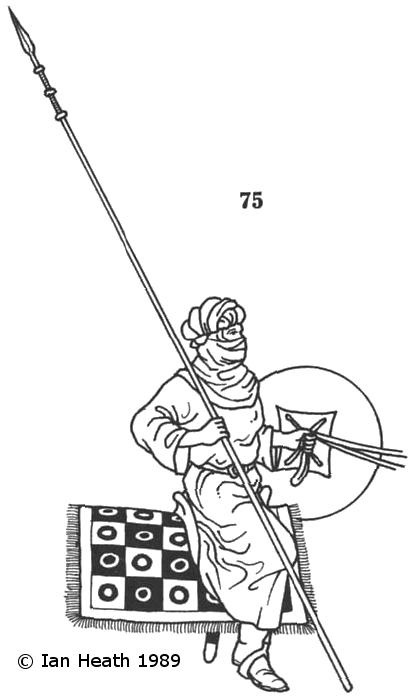
Amazon Audible Gift Memberships

MURABIT CAVALRYMAN, 11th CENTURY
An extract from Armies of Feudal Europe 1066-1300by Ian Heath


75. MURABIT CAVALRYMAN, 11th CENTURY
The most distinctive feature of the Murabits was their veiled turban, adopted from the Lamtunah Berbers, a branch of the Sanhaja tribe. The modern Touaregs, descendants of the Sanhaja, still wear such turbans today, which are usually very dark blue like their long topcoats, though some subject tribes wear white. Many of the Murabits, however, appear to have worn black topcoats and cloaks and therefore, presumably, black veils. (Several modern authorities say the Murabits wore blue and striped clothes and black sandals but do not cite their source for this.) It was the characteristic veiled turban, the litham, which gave rise to an alternative name for the Murabits - Mulathamun, meaning 'Veil-wearers' or 'Muffled ones'. Some Andalusian and even Negro mercenaries in Murabit employ also adopted the veil.
The Murabits carried typical Berber armament of lance, javelins, sword and shield, the last apparently often of hippopotamus hide. In addition a sheathed dagger would probably have been strapped to the left forearm, a Berber practice recorded in the 6th century and still customary amongst the Touaregs today. Murda al-Tartusi, who wrote a military manual for Saladin in the second half of the 12th century, described the Berber lance, which he called kabarbara, as having a shaft of 5 arm's-lengths (ie, about 11½-12½ feet) with a blade of another one arms-length, making a total of 13½-15 feet. Although this was in Almohade times, there is no reason at all to suppose that Berber weapons changed along with their dynasties (though the 'Cántigas' pictures significantly depict shorter lances of only 9-10 feet - see figure 78). If armour was worn at all (improbable prior to the conquest of Andalusia, and uncommon among the Murabits themselves even thereafter) it was probably concealed beneath the flowing robes of camel-wool described as their characteristic costume by contemporaries. The clothing of both Murabit and Almohade chieftains alike was generally decorated with Coptic designs, which involved geometrically patterned bands and polygonal motifs.
Each Murabit or Almohade cavalry unit had its own flag and drums, the Murabits at least being trained to manoeuvre to the roll of drums.
[Based on Cantiga 28 of the Cantigas de Santa Maria of Alfonso X]